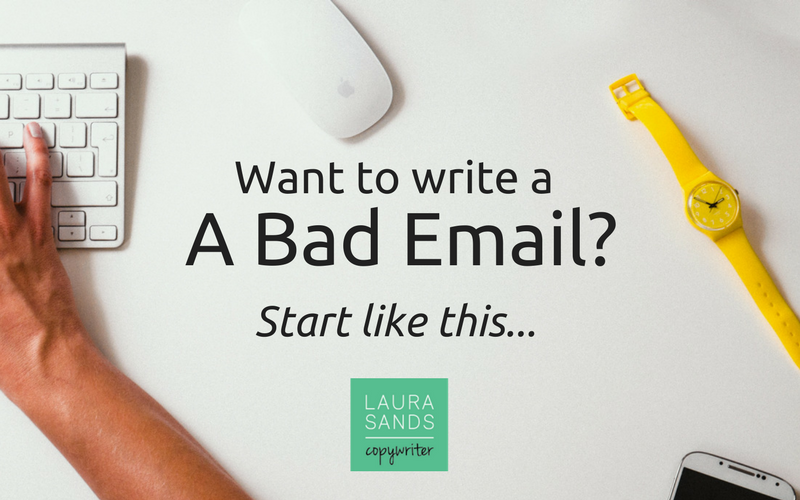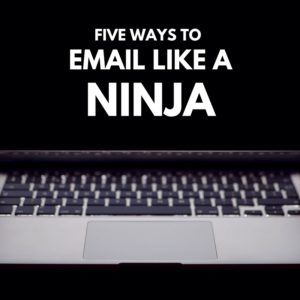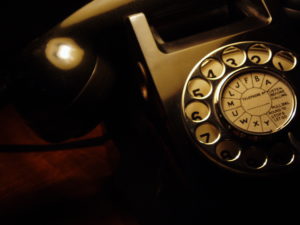 It slips off your tongue easily and finds its way off your fingers and onto a keyboard even more easily. But kicking off with an apology is one of the fastest ways I know of starting an email on the wrong foot.
It slips off your tongue easily and finds its way off your fingers and onto a keyboard even more easily. But kicking off with an apology is one of the fastest ways I know of starting an email on the wrong foot.
Sorry. Forgive me. My apologies. Whoops-a-daisy. My bad.
You get the picture.
Why you shouldn’t start with sorry
The person reading your email will be ready to wonder what you’ve done. Should they feel aggrieved? Impatient? Irritated? You’re certainly suggesting they have a right to be. As we humans are highly suggestible there’s a chance that even if they weren’t aware of the wrong you’d committed, and couldn’t have given two hoots, they may be a bit less than impressed with you than they were 10 minutes previously.
An example…
Let’s say you’ve sent something a bit later than promised. Train delays, kids off school, cat to the vets with a mystery cough… life happens. You finally whizz off the email to your contact, starting with an almost out of breath “sorry this is so late…”.
What’s the first thing the recipient thinks? “urgh… late again”. They sigh as they sip their coffee and add a little black mark against your name in their imaginary list of “people I deal with”.
If you were just an hour or so late, you’d have been better not mentioning it at all. There’s a chance they hadn’t even realised your note was late. If you were over a clear deadline or a day or so late, you could replace an effusive apology with a more assured “thank you for your patience…” – a trick you might have seen elsewhere.
Thank you for your patience
It’s something doctors say, you’ve probably heard it before…
You’ve been waiting in a stuffy waiting room with only copies of the “People’s Friend” for entertainment. It’s been 45 minutes and you’re ready to create merry hell. The doctor eventually calls you in and says “thank you for your patience”. They may even explain why they’re so over their schedule. Because your doctor is lovely and you know they do a good job, you readily forgive. After all, you don’t mind being patient do you?
Instead of apologising for a small and understandable deficiency on their part, the doctor praises you for a positive behaviour. It’s a small thing, but it makes a big difference to the way you feel. “Thank you for your understanding” works just as well. You make people feel good about their behaviour, shifting the emphasis off yourself. But sometimes this isn’t appropriate; perhaps a big fat “sorry” is in order.
When the situation demands an apology.
You don’t need me to tell you this. In situations that require an apology, you should say sorry.
But you don’t need to start your email with an apology. Get into the solution, help resolve the situation. Something along the lines of “I see what has happened. I’ll get back to you with XYZ by lunchtime tomorrow”. Then add your apology.
In fairness, if you’ve made a mistake that demands an apology you probably need to get on the phone and talk it through. But because you’ll be following up that phone call with an email as well, you need to remember to think carefully about how and where you place that necessary apology.
Sorry? What was that?
Say sorry. Show sorry. But start an email with a “sorry”? There’s never any need to do that.
Do you agree? Or not? Let me know.
5 Ways to Email Like a NinjaIt’s quite likely that emailing is a huge part of your working life. And hallelujah to that. So the chances are you’ve become something of an email ninja, powering through dozens of emails and making the most of this technological gift. Emails speed things up, save wasteful paper trails, and mean we don’t have to to rely upon the postman, or even worse; actually talking to each other – perfect for introverts, the busy and anyone avoiding confrontation…

But every silver lining has a cloud lurking above it. And don’t we know it? The rage, the irritation, the relentless back-and-forth that emails regularly cause are the stuff of workplace legend. But a true email ninja doesn’t let this bother them, and they certainly don’t inflict email pain on others.
Want to know how to email like a Ninja? Here are 5 tips to get you started
1. The Email Ninja Understands the Reader.
There’s a time & a place for smiley faces and kisses, (in emails to your sister, your friends and contacts you’ve had forever, in case you were wondering), and if you don’t know the recipient then they play it safe.
Doing a bit of reader research is wise if your email is important (and why would you send an email that wasn’t important?). Take some time to understand if your recipient is a decision-maker or if they have to influence someone else. Make the reader’s job easy and let them know what you want them to do with bold and simple call to actions.
2. The Email Ninja is Always Well-Mannered.
Manners cost nothing. Emails are about building a relationship and getting a job done, so consider the social graces you’d use when building a face-to-face relationship, and apply them in your digital communications.
Directness can come across as being gruff and rude, and will do nothing to help your cause. Consider also that over-use of good manners can appear fawning and make you look like a walk-over, or even worse, insincere.
So remember your manners, but don’t overdo it – simple salutations, polite farewells and the regulation please and thank-yous should do the job.
3. The Email Ninja Embraces White Space.
White space has magical properties.
Honestly it does.
Add in some paragraphs and bullet points and see your writing come to life. A block of solid text causes snowblindness and slows your reader down. Careful punctuation, spacing and paragraphing will help you make your point, “manage” your reader, and get your point across.
See? Magic.
4. The Email Ninja Doesn’t Abbreviate.
Thx, Pls, BR, comms; abbreviations may be standard within certain businesses but are often needless. It’s often a habit, but try to make the effort to use the full word or term – that way you can be certain your recipient will understand what you’re talking about. For instance – I use the term “CTA” to denote “Call to Action”. A quick Google reveals that “CTA” can also be used to refer to Chartered Tax Advisers, Celebrity Talent Academy, and the Chicago Transit Authority. How could I be certain that my email recipient would know which “CTA” I was referring to?
Don’t assume that others will understand your abbreviations. At the best you will make them feel as if you are on different wavelengths, at worst you could be working on something entirely different and not know it until far too late.

Sometimes it’s better to just pick up the phone
5. The Email Ninja Understands the Limitations of Email.
Emails are great, but aren’t fail-safe. Phone calls, video-conferences, actual face-to-face meetings … the personal touch will nearly always result in a better outcome. An email may seem like the faster/clearer/less controversial route, but who hasn’t been involved in a hugely confusing email chain that goes on and on? Pick up the phone, meet for a coffee, use the breadth of communication tools available to best effect. In business as in nature, it’s the ability to adapt that allows us to thrive.
Be an Email Ninja
The Email Ninja makes the most of the tools available and uses them to their best effect, but most importantly, they don’t rely upon a single medium. It’s often when using a new technique or unusual method that we reap the best results – so the Email Ninja will mix things up a bit and use more than just email.
Use your emails skilfully and at the right time and place. Then you’ll gain your place as an Email Ninja.
The Email Ninja is always willing to learn. What are your tips for emailing like a Ninja? Let me know by posting a comment.
